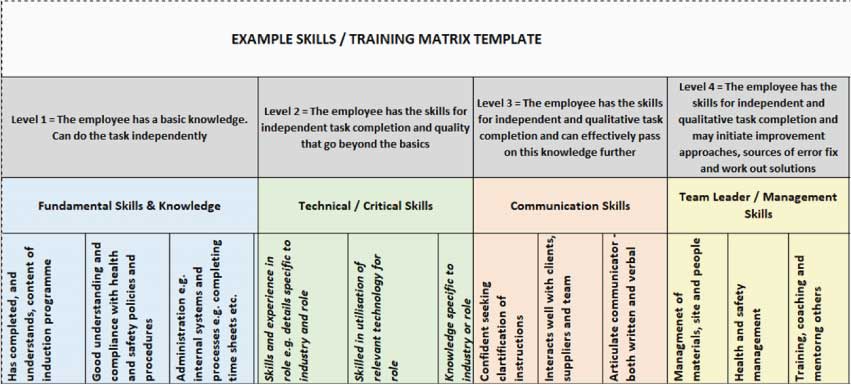

Developing your training matrix for employee development
Our 2020 blog on the Employee Skill Matrix covered the role of the Employee Skill Matrix, particularly in terms of ensuring change management processes are undertaken fairly and carefully. It also described how a skill / training matrix can be useful in providing a structure for a variety of other important business processes that require sensible well thought out moves, whether they be temporary or permanent.
A training plan is an essential business tool for businesses of all sizes
The training plan can be used for many purposes. For example, when analysing organisational processes and comparing with the existing team’s capabilities, it is advantageous to know what skills, qualifications & competencies your employees have.
This type of analysis allows you to quickly identify gaps in training or weaknesses in skills, also to know who has the required skill sets to carry out certain roles or tasks within the business. From a health and safety perspective, you can keep track of team member’s training records and the status of qualifications/certificates i.e., whether they are valid, expiring, or expired & ensuring your business’s compliance.
Situations when a skills / training matrix is valuable:
- visually showing the tasks and skills required for specific roles and the current competency and skill level of each employee for each task;
- knowing who can be re-deployed during periods of peak in demand or if a person is off sick;
- when planning the implementation of a new project or technology, identifying employees: who have the skillset required; who could train others; and who needed training on what and when;
- gathering important information for proposed restructures, and changes to employee roles;
undertaking succession planning; - ensuring compliance by managing essential regulatory training and certificate updates e.g., fork-lift training and first aid certificates;
- working with team members on their personal development plans;
- setting staff training and development budgets; and
- demonstrating that the business is actively training and upskilling New Zealanders when applying for Employer Accreditation with Immigration New Zealand.
The matrix itself can be prepared on a simple Excel spreadsheet or electronically via an online system.
Irrespective of what method selected, steps involved in building a training matrix include:
- Listing all roles within the business (i.e., the positions);
- Nominating the key skills required for each of the positions, the relative level of experience or competence required, and the relative importance of the skill to your business (NB: key roles require a robust succession plan to be in place);
- Looking at each individual and working through the list of training requirements, recording whether it is a requirement for their job role or not. Where there is a requirement, record if the person holds the necessary certificate or qualification and where possible, the expiry date. If there is a requirement and their certificate is missing, record this also.
- Rating each employee against each of the required skills for each role (regardless of the role they are presently in, taking into account the level of skill and level of experience.
This process should give you the crucial data you need to determine your training and development needs and to develop a training plan and budget.
Another important step in the overall process that goes hand in hand with this is having a relevant Learning and Development Policy and Performance Appraisal Process as this is where managers identify learning needs jointly with employees.
Below is an example of a simple skills/training matrix template.

Technological and societal changes are coming at us thick and fast, and we need to keep up with the various skill and training requirements associated with change.
Your employees are a core and valued resource in your business and as such, there is a real need to have a continued focus and investment on growing staff capability. This approach also helps them to achieve their career goals and aspirations while at the same time contributing to your business success.
A skill / training matrix approach is an important business tool to assist you with this.
If you have any questions about setting up a skill / training matrix, a Learning and Development Policy, performance appraisal processes or you would just like some general HR guidance and expert advice, please give us a call, we would be very happy to assist you.
